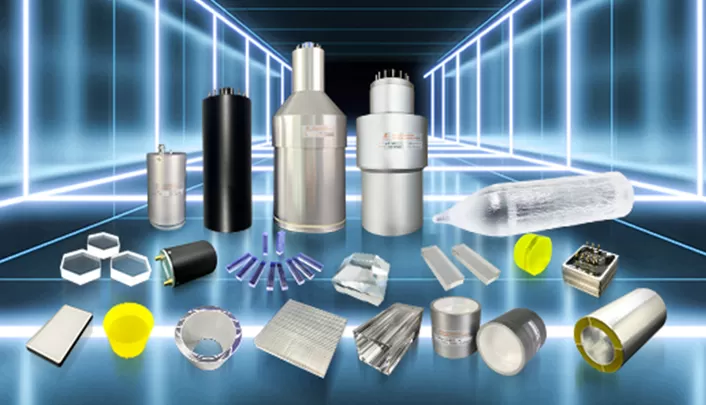
Scintillation crystals and detectors will be involved specifically tailored, in order to meet the specific requirements of a particular application and achieve desirable results. The process of customization include several aspects, such as materials composition, unique crystal shape and dimensions, surface treatment, reflector applied and package, and light sensors PMT, SiPM or PD to be coupled, as well as the electronic parts amplifier and voltage divider.
In Epic Crystal our engineers have more than 20 years experience with scintillation crystals. We owned crystal grow furnace based on Bridgman and Czochralski technology, a complete set of crystal processing equipment, such as line cutting, inner circle cutting, grinding and polishing machine with stable array assemble line, and abundant experience on the detectors assembly with PMT, SiPM or PD, as well as characterization and inspection platform. Thus we are capable of proceeding the special request according to customers requirement.

Composition
The scintillation crystals can be customized by adjusting its chemical composition to optimize its performance for a specific application. For example, adding a small amount of dopant that can enhance the crystal's light output, like Thallium doped Sodium Iodide NaI(Tl) and Cesium Iodide CsI(Tl). Even alert the decay time of scintillation process, like Yttrium doped Barium Floride BaF2-Y. Co-doping with multiple elements can enable adjustments to the energy response or improve the scintillation efficiency, like Calcium co-doped LYSO(Ce) LYSO(Ca, Ce).

Size and shape
To detect nuclear radiation with a certain efficiency, the dimension of the scintillator should be chosen such that the desired fraction of the radiation is absorbed. The thickness of a scintillator can be used to create a selected sensitivity of the detector for a distinct type or energy of radiation. For example thin (e.g. 1 mm thick) scintillation crystals have a good sensitivity for low energy X-rays but are almost insensitive to higher energy background radiation. Large volume scintillation crystals with relatively thick entrance windows do not detect low energy X-rays but high energy gamma rays are measured efficiently.

Surface finish
Surface treatments such as cutting, lapping, polishing(mechanic and chemical) or coating can be applied to crystals to minimize light scattering, improve its light collection efficiency and acquire good uniformity as well as good energy resolution. For example, a customized scintillation crystal may be grinding into a specific particle size(µm) with different sandpaper W14, W20 or W28 etc. It may also be required mechanic polished to increase the amount of photon that reaches to light sensors, or chemically polished to improve its transparency, S/D and improve the uniformity of the scintillation response across the crystal surface.

Reflector
Reflector materials, such as Magnesium Oxide(MgO), Titanium Dioxide(TiO2), Barium Sulfate(BaSO4), Enhanced Specular Reflector(ESR,3M) or Teflon, when it come to apply on single scintillation crystals, the light collection efficiency can be enhanced. And those reflectors can be applied into pixellated crystals to minimize the cross talk from pixel into neighboring ones. For example, BaSO4 and ESR used in LYSO(Ce) and BGO for PET/SPECT application, TiO2 in CsI(Tl), CdWO4 and GOS for industrial CT or X ray security inspection. And special materials like Lead(PB) or Tungsten(W) were added together to achieve desirable results.

Package
The scintillation crystals can be customized with a specialized encapsulation that optimizes their performance and protects it from environmental factors such as humidity, temperature, shock and vibration. For example the hygroscopic NaI(Tl), LaBr3(Ce) and CeBr3, all of them require aluminum housing and optical window to prevent them from moisture attacks. While during the applications with harsh conditions, such as measurement while drilling(MWD), in which it always involve high temperature, shock and vibration, special package by SS or Titanium housing with welded glass is necessary.

Photo-detectors selection
Photo-detectors devices can convert the light emitted by scintillators into electrical signals. Different type of scintillators emit light within various spectral wavelength ranges, requiring different photodetectors to optimize their response to specific spectra and enhance detection performance. In space-constrained situations, smaller SiPM and PD can be selected. Depending on the crystal size and measurement accuracy requirements, SiPM arrays or PD arrays may be used then. Additionally, using appropriate photodetectors can optimize the detector`s noise level and temporal response characters.

Coupling material and geometry
Light guide enable complex optical path deisgns. Light guide glass connects crystals of different shape with photodetectorsm while optical fibers are used for long distance transmission. Coupling materials fill interface gaps, reducing reflection and scattering to ensure efficient light transmission. Optical silicone grease has high transparency, optical adhesive provide strong bonding, and silicone grease gaskets offer good elasticity to adapt to differnet interface shapes. Precise interface design and material selection can minimize light signal loss and nosie during transmission.

Signal readout electronics
Nuclear electronics components include preamplifiers, voltage dividers, counting modules, multichannel pulse amplitude analyzers, and wireless transmission modules etc. Different types of readout circuits are required for gas detectors like GM tubes, scintillator detectors coupled with PMT or SiPM, and semiconductor detectors like HPGe. For applications involving nuclide analysis and activity measurement, spectrometers with nuclide identification and activity measurement functions are needed. Coincidence-Anticoincidence measurement require multichannel pulse amplitude analyzers and timing measurement modules.